Service history
After shakedown training out of Westwego, Louisiana, and Galveston, Texas, Grainger was assigned to the Naval Training Center, Miami, Florida, for duty as a school ship. She trained personnel in cargo handling and ship operation and maintenance until 14 September, when she departed New Orleans and proceeded by way of the Panama Canal Zone to arrive at San Pedro, California, 12 October.
Departing San Francisco 31 October Grainger sailed for Saipan, Tinian, Guam, and Seeadler Harbor, Manus Island. Having discharged all her cargo she left Manus Island 17 February 1946 and after touching at Pearl Harbor reached San Francisco 13 May. Ten days later Grainger proceeded to Seattle, Washington, and arrived there 26 May and began her inactivation overhaul. She was decommissioned there 25 July 1946 and returned to the Maritime Commission the next day. Her name was stricken from the Navy List 15 August 1946.
Post-war reactivation
Grainger was taken into the Navy again 9 May 1947, and commissioned 12 June 1947, at the Puget Sound Naval Shipyard, Bremerton, Washington and her name reinstated on the Navy List 23 June. Departing Bremerton she reached San Diego, California, 18 July, then sailed for Port Hueneme, California.
Departing Port Hueneme 21 August 1947 Grainger touched at Pearl Harbor before she arrived at Guam 19 October, to take up duty there. Grainger supplied the Mariana Islands and the Eastern Caroline Islands, with occasional trips to the Palau Islands until 9 April 1949 when she arrived Pearl Harbor.
After overhaul Grainger cleared Pearl Harbor 13 July and touched at San Francisco before reaching Seattle 16 August. Departing Seattle 28 August she carried out cargo operations at Kodiak and Adak, Alaska, before returning to Seattle 2 October 1949.
Grainger cleared Seattle a week later to take up her duty at Guam again, arriving there 20 December. She carried out her operations for the next 6 months supplying the Marshall Islands and the Mariana Islands.
Korean War support
With the outbreak of hostilities in Korea and shortage of ammunition ships in the Far East Grainger loaded with aircraft ammunition and cleared Guam 14 July 1950. She was to rendezvous with Admiral Arthur Dewey Struble's Task Force 77 on the 23d and rearm the carrier Valley Forge, but due to weather conditions had to complete her mission in Sasebo, Japan, the next day.
Here Grainger was assigned to the Logistics Support Group, Captain B. L. Austin, for the U.S. 7th Fleet as a replenishing ammunition ship. She continued this important job until 15 September when she got underway for the objective area in support of the landings at Inchon, one of the most successful amphibious operations in history. Grainger participated in the landings 16 September, and after landing her cargo remained in Inchon Harbor until 7 October, when she retired to Sasebo.
Departing Sasebo 21 October 1950 Grainger returned to Guam on the 28th and resumed her task of logistic support to the Marianas and the Carolines. Departing Kwajalein 2 March 1951, Grainger sailed for Pearl Harbor arriving 13 March. Here she took up duty contributing logistic support to Midway Island and Kwajalein atoll until 18 June 1953.
The ship then cleared Pearl Harbor to take up duty in Sasebo, where she arrived 12 July. With the exception of a voyage to Inchon, Korea, with refrigerated and dry stores for occupation troops, 6–13 October, Grainger steamed between Sasebo and Yokosuka until 19 March 1954, returning to Pearl Harbor 2 April, to take up her familiar runs to Kwajalein and Midway Island. Grainger again rotated to Sasebo, sailing on 5 March 1955, and she arrived there 29 March. Her visits included Buckner Bay, Okinawa; Subic Bay, Philippine Islands; Kaohsiung, Formosa; and Hong Kong.
Final decommissioning
Grainger departed Yokosuka 11 September, and going by way of Pearl Harbor reached Long Beach, California, 20 October 1955; 2 days later she shifted to San Diego, California, to undergo inactivation overhaul. Grainger decommissioned there 7 February 1956, and was turned over to the San Diego Group, Pacific Reserve Fleet.
Grainger remained out of commission in reserve there until she was disposed of and her name stricken from the Navy List 1 April 1960. The veteran cargo ship was advertised for sale twice, 7 July and 11 August 1960, but the Maritime Administration rejected both bids. Ultimately, however, The Learner Co., a Japanese firm, successfully bid on 17 October 1960, purchasing the vessel as a scrap hull on 17 October 1960, the title transfer taking place on 14 December 1960 and the vessel being delivered at San Diego.

USS Abnaki (ATF-96) was the lead ship of the Abnaki class of fleet ocean tugs in the service of the United States Navy, named after the Abenaki tribe of Native Americans. She was laid down on 28 November 1942 at Charleston, South Carolina by Charleston Shipbuilding & Drydock, launched on 22 April 1943, sponsored by Mrs. James Mayon Jones, and commissioned at the Charleston Navy Yard on 25 November 1943. Abnaki earned three battle stars for service during the Korean War and 10 battle stars during the Vietnam War.

The USS Alnitah (AK-127) was a Crater-class cargo ship in the service of the US Navy in World War II. Named a spelling variation of the star Alnitak in the constellation Orion, it was the only ship of the Navy to bear this name.

USS Leo (AKA-60), an Andromeda-class attack cargo ship, was named for the constellation Leo. She is the only ship of the United States Navy to hold this name. USS Leo served as a commissioned ship for 10 years and 5 months.
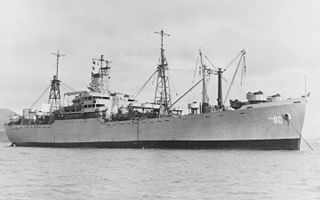
USS Whiteside (AKA-90) was an Andromeda-class attack cargo ship named after Whiteside County, Illinois. She served as a commissioned ship for 13 years and 4 months.

USS Virgo (AKA-20) was an Andromeda class attack cargo ship of the United States Navy, named after the constellation Virgo. She was later converted to an ammunition ship and redesignated as (AE-30). She served as a commissioned ship for 22 years and 4 months.
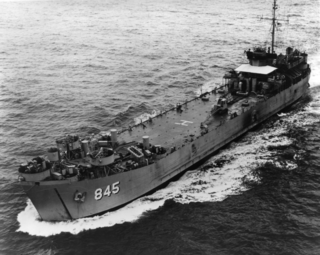
USS Jefferson County (LST-845) was an LST-542-class tank landing ship built for the United States Navy during World War II. Named after counties in 25 states, she was the only U.S. Naval vessel to bear the name.

USS Logan (APA-196) was a Haskell-class attack transport of the United States Navy, named for counties in Colorado, Illinois, Kansas, Kentucky, Ohio, Oklahoma, Nebraska, North Dakota, and West Virginia. The Haskell-class design, United States Maritime Commission standard type VC2-S-AP5, is a sub type of the World War II Victory ship design.

USS Luzon (ARG-2) was an internal combustion engine repair ship in service with the United States Navy from 1943 to 1947 and from 1950 to 1960. She was the lead ship in a class of twelve ships and was scrapped in 1974.
USS Keosanqua (ATA-198) was a Maricopa-class auxiliary fleet tug of the United States Navy. The ship was authorized as Rescue Ocean Tug ATR-125, and redesignated Auxiliary Fleet Tug USS ATA-198 on 15 May 1944. The ship was laid down at Levingston Shipbuilding Co., Orange, Texas, launched on 17 January 1945, and commissioned on 19 March 1945. She was named Keosanqua (ATA-198) on 16 July 1948.
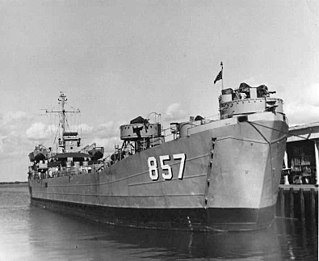
USS King County (LST-857) was an LST-542-class tank landing ship built for the United States Navy during World War II. Named after counties in Texas and Washington, she was the only U.S. Naval vessel to bear the name.

USS Pitkin County (LST-1082) was an LST-542-class tank landing ship built for the United States Navy during World War II. Named after Pitkin County, Colorado, she was the only U.S. Naval Vessel to bear the name.
USS Vega (AK-17), was a Sirius-class cargo ship of the United States Navy, originally the Lebanon — a single-screw, steel-hulled Type 1022 freighter, built under a United States Shipping Board contract at Hog Island, Pennsylvania, by the American International Shipbuilding Co. Laid down on 8 July 1918, the ship was launched on 18 July 1919. Acquired by the Navy on 2 December 1921, she was renamed Vega and given the classification of AK-17. She fitted out for Navy service, and was commissioned at the Boston Navy Yard on 21 December 1921.

USS Chickasaw (AT-83/ATF-83) was a Navajo-class fleet tug constructed for the United States Navy during World War II. She served in the Pacific Ocean in World War II and the Korean War, and was awarded six battle stars for World War II and two battle stars during the Korean War.

USS Lafayette County (LST-859) was an LST-542-class tank landing ship built for the United States Navy during World War II. Named after counties in Arkansas, Florida, Mississippi, Missouri, and Wisconsin, and a parish in Louisiana, she was the only U.S. Naval vessel to bear the name.
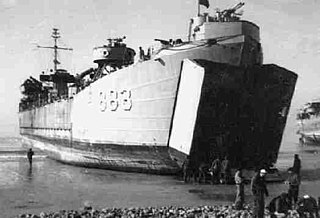
USS La Moure County (LST-883) was an LST-542-class tank landing ship built for the United States Navy during World War II. Named after LaMoure County, North Dakota, she was the first of two U.S. naval vessels to bear the name.
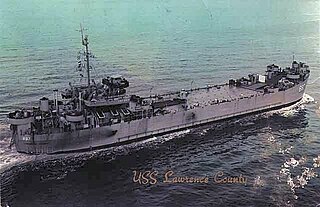
USS Lawrence County (LST-887) was a LST-542-class tank landing ship built for the United States Navy during World War II. Named after counties in eleven U.S. states, she was the only U.S. Naval vessel to bear the name.
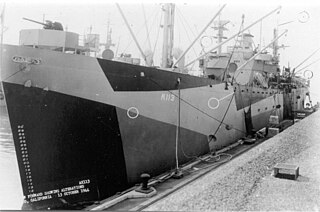
USS Rutilicus (AK-113) was a Crater-class cargo ship commissioned by the US Navy for service in World War II. She was responsible for delivering troops, goods and equipment to locations in the Asiatic-Pacific Theater.

USS Ara (AK-136) was a Crater-class cargo ship commissioned by the US Navy for service in World War II. Ara is named after the constellation Ara. She was responsible for delivering troops, goods and equipment to locations in the Asiatic-Pacific Theater.
USS Pavo (AK-139) was a Crater-class cargo ship commissioned by the U.S. Navy for service in World War II, named after the constellation Pavo. She was responsible for delivering troops, goods and equipment to locations in the war zone.

USS Sussex (AK-213) was an Alamosa-class cargo ship that was constructed for the US Navy during the closing period of World War II. She was retained by the Navy for post-war service, including that in the Korean War theatre where she earned three battle stars and then returned home for deactivation.

















